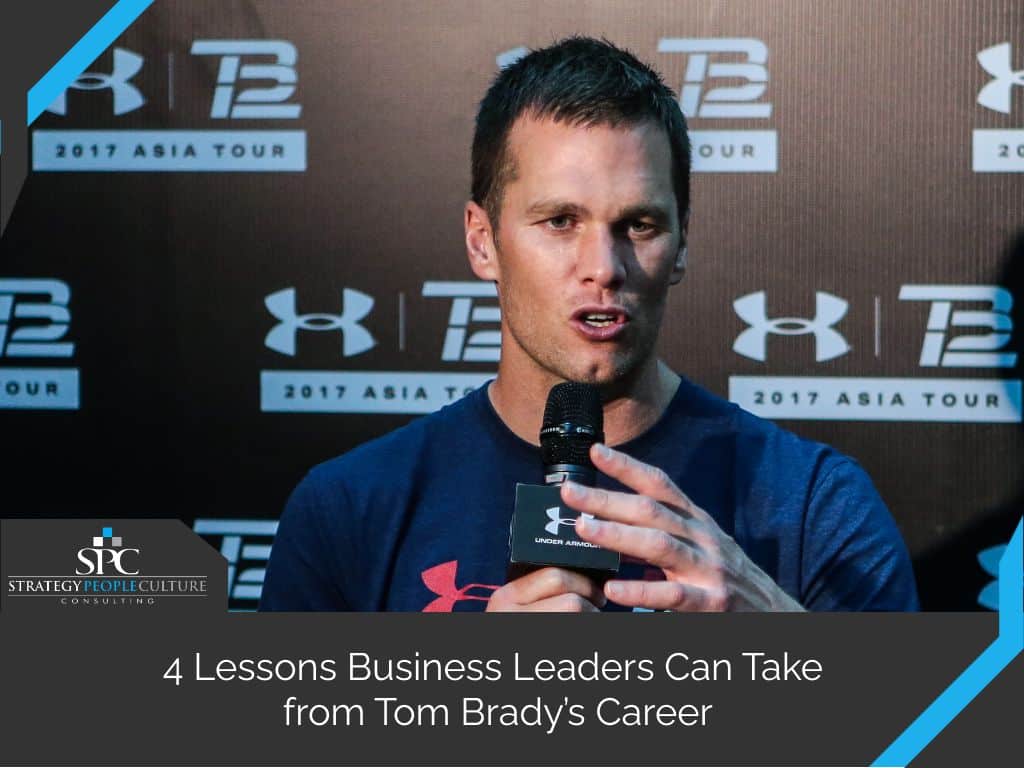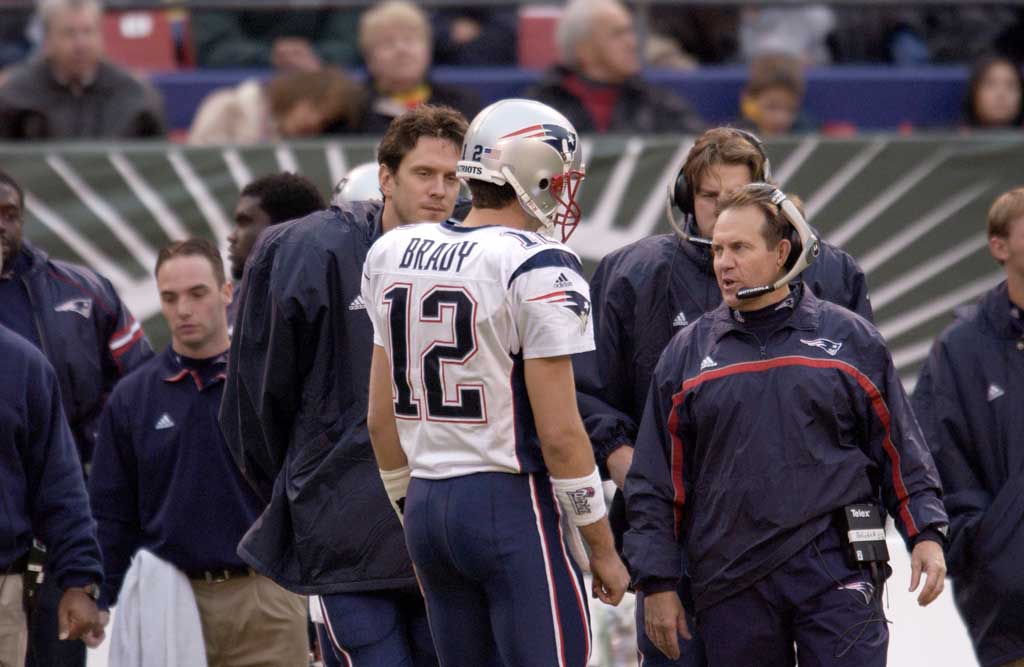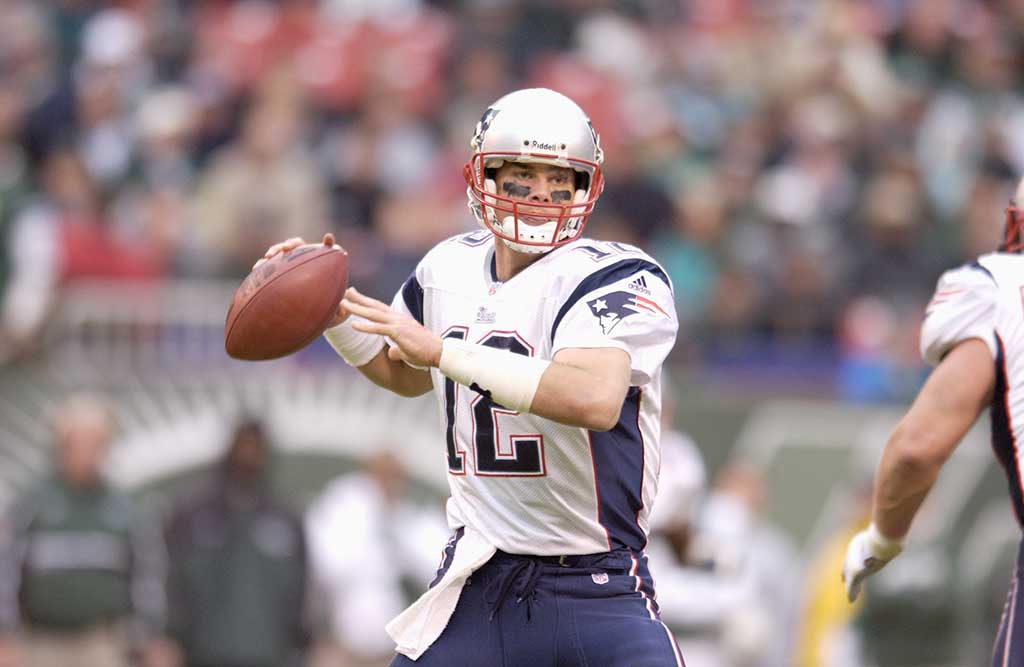4 Lessons Business Leaders Can Take from Tom Brady’s Career

Another crazy NFL season, another Super Bowl ring for Tom Brady. Brady has long been the gold standard for an NFL quarterback. But more importantly, the impact he has on a football team has been a leadership lesson that transcends the NFL.
Brady has had many memorable years throughout his near-two-decade tenure in the NFL, but none quite as remarkable as this past one. Within twelve months, Brady left the team he played his entire career with (New England Patriots), joined a new one (Tampa Bay Buccaneers) for the 2020 season, and brought them a Super Bowl victory.
What’s truly remarkable is the 2019 Tampa Bay Buccaneers had a lot of talent yet ended the season with a below-average record. With largely the same team and coaching staff, the addition of Tom Brady ended with them winning it all.
The difference is leadership.
To transfer this phenomenon to the business world, it begs the question: if a company makes $100m EBITDA under average leadership, could effective leadership result in making $125m or more – with the variables being largely the same?
This post wants to help answer this question with four key lessons business leaders can take from Tom Brady’s Hall of Fame career.
Let’s get started!
1. Stellar Talent Doesn’t Always Translate to Stellar Leadership
One of Tom Brady’s most fascinating details isn’t related to his skills on the field.
While certainly an elite talent, he hasn’t always had to rely on eye-popping heroics to bring his team to a championship level.
He doesn’t own many regular-season records, and he hasn’t been a statistics leader like Aaron Rodgers, Drew Brees, or Peyton Manning. Yet, he has almost twice as many Super Bowl victories as the three of them combined.
Tom Brady’s true talent lies in his ability to create a winning culture within his organization.
19 years ago today the @patriots took a chance on the guy in this photo: Me (199) 😂. Thank you to EVERYONE who’s helped me to prove them right!
Also, did they stop taking these photos after mine?? 🤣🤣 pic.twitter.com/qxBoCc0F1H
— Tom Brady (@TomBrady) April 16, 2019
For comparison, let’s examine former Philadelphia Eagles quarterback Carson Wentz.
He was the number two pick overall in the 2016 NFL draft and was touted as one of the most talented QBs in his first few seasons. However, as of this writing, he has never managed to win a playoff game.
Ironically, the Eagles won the Super Bowl with backup quarterback Nick Foles in 2017, when Wentz was injured.
After 12 weeks of poor play in 2020, Wentz was benched for rookie Jalen Hurts. Slowly, stories began trickling in about shortcomings in Wentz’s leadership abilities, including an inability to take criticism, apply coaching, and accept blame for failures. A general observation in the sports world was that players played harder when Nick Foles and Jalen Hurts were the starting quarterbacks[AB2] [KS3].
Stepping back from public perception, objectively, Wentz has been highly successful. With his current contract, he will have earned circa $150m by his early 30’s. Let’s face it, many people would trade their lots in life with that of Carson Wentz. That said, hypothetically assume he had similar leadership skills and work ethic to Tom Brady; what do you think Carson Wentz’s career and level of success might look like?
Wentz was recently traded to the Indianapolis Colts and had the opportunity to start fresh and learn from the past.
The Wentz-Brady comparison is good evidence that talent will only take you so far as a leader.
A common thread throughout Brady’s career is his understanding that reaching peak potential requires a humble effort both on and off the field. Additionally, success as an NFL quarterback comes down to how your peers view you.
Failing to accept criticism, passing blame to others, and not being coachable are three fatal characteristics of young NFL quarterbacks – and business leaders.
To transfer this insight to the business world, real talent stems from motivating those around you. To solidify this notion, I want to touch on the idea of coaching in business.
Let’s compare NFL coaching to executive coaching.
Being “coachable” in the NFL largely relies on the ability to put ego aside, take orders from the chain of command, and make mutually beneficial decisions for the organization. Coachability in executive coaching is about looking inwardly at what you can do to better yourself as a leader. The goal is to become a leader that people want to follow.
As we examine Tom Brady’s career, he’s successfully combined the benefits of both NFL and executive coaching. This leads right into my next point.
2. Understand the Ripple Effect of Your Role
Tom Brady’s leadership has been a fascinating case study throughout his career. He’s a ruthless competitor and perfectionist on the field, yet always calm and collected off the field. There haven’t been stories of Brady letting loose in strip clubs, stealing, or assaulting anyone. Instead, he’s always been a classy, show-don’t-tell leader who doesn’t make immature mistakes.
To circle back to executive coaching, Brady has long been praised for holding himself and others accountable. Joe Judge, current coach of the New York Giants – who worked with Brady for eight years on the Patriots – credits this trait as the one that sets him apart from most players.
In many ways, the way Brady carries himself as a leader has had the largest ripple effect on both the Patriots and Buccaneers, whether it’s a quarterback in the NFL, CEO of a Fortune 500 company, patriarch of a family-run business, or head of a startup, the demeanor, attitude, and actions of a leader impacts the mindset of everyone else.
As an executive, your actions inside and outside of business hours set the tone for everyone else. If you are loud, immature, and are unsupportive of your staff, you are more than likely creating a less productive work environment.
On the flip side, exhibiting emotional intelligence and going the extra mile to give your staff support will motivate people to reciprocate. So, ultimately, your goal as an executive is to foster an environment where staff genuinely want to go the extra mile – because they believe in you and know you’re in their corner.
These are the fundamentals of executive coaching: being aware of how your mindset and actions impact the workplace culture.
Are you doing everything you can to create an organization that wins?
Or are you holding people back from reaching their peak potential?
3. Be Receptive to Challenge
Throughout Brady’s long career, he’s had a keen ability to embrace challenges.
He was picked in the sixth round at #199 of the NFL Draft, overlooked by almost all the experts for starters.
He’s been the underdog in three Super Bowls throughout his career – and he’s 3-0 in those games. Before the 2016 season, ESPN analyst Max Kellerman famously claimed Brady would “fall off a cliff soon” in a segment of First Take:
Since this statement, Brady has won three Super Bowls on two different teams and a league MVP award in the five years. Few people in history have been able to embrace challenges quite like Tom Brady.
Throughout his career, he’s played with many different rosters. Some have been stacked with talent, while others have been below average. Regardless, he has always stepped up and delivered in big ways. Brady has never seen a losing season and has only missed the playoffs once.
What’s the takeaway here?
Raw talent is important, but a great leader can maximize the talent they are working with and make everyone around them better. This is one of the biggest lessons (and goals) of executive coaching.
Shifting back to Brady, one of the more interesting challenges he has tackled in his 20+ year career is simply staying relevant off the field. Unlike many of the “older” quarterbacks, Brady has evolved his star presence over the past two decades.
If you look at his Instagram feed, it’s clear he can connect with multiple generations of football fans. Moreover, Brady can work well with less experienced players, which he has praised in Tampa Bay.
This is a challenge that many athletes struggle with within the twilight years of their careers.
Your company is going to evolve. Your staff will be bringing on new talent. And more importantly, your target market will be evolving as time goes on. The ability to adapt to the changing world around you is crucial for staying in touch with your employees and customers.
4. Lead by Example, Always.
Tom Brady’s work ethic and personal habits are no secret. Not even the stoutest Brady detractors can deny preparedness for a game is world-class.
He’s built a reputation on being extremely detail-oriented in game prep – and he’s written a book on his diet & workout regimen. This has been the foundational component of his career success, and it’s contagious.
As an executive, the standards you set for yourself flow throughout the organization.
People look up to you and follow your lead; that’s the reality of the job. Leading by example influences how people perceive you, respect you, and decide whether or not they want to stick around.
So how can you do this day-to-day?
Take Ownership
The best leaders can pass credit and take the blame. If you do it the opposite way, you risk making your team wary of your leadership style and compromise trust.
Take Care of Yourself
This is a big page to take out of Brady’s book. Leadership starts with being healthy – both mentally and physically. Yet, all too often, we see companies expect employees to work themselves to the bone and break their backs on projects.
Balance is everything in a productive workplace. Being an advocate for a healthy work-life balance does not mean not working hard; rather, it means finding those pauses to ensure you do not face burnout, lose enjoyment in what you do, or forget why you are working hard in the first place. By leading a healthy, balanced life, you’re encouraging your employees to do the same.
Commit to Excellence
If you want exceptional results from your staff, be exceptional. To reiterate, everything you do as an executive is observed and emulated. If you’re not giving 110%, why should they?
When you produce excellent results, you are setting the standard – and your staff will do their best to keep up.
The Wrap
Many of the people who have worked and played with Tom Brady have said he is a great player and an even better person. But, believe it or not, there will be a day when Tom Brady retires. When he does, his legacy will be unmatched both on and off the field.
Business leadership and NFL leadership have a great deal of overlap. The best results start with a team-focused mentality, a commitment to helping those around you get better, building productive relationships, and setting high standards.
So to answer our earlier question: if a company makes $100m under average leadership, could effective leadership result in making $125m or more – with the variables being largely the same?
The answer is an absolute yes!
Have you been pondering how you can make your organization better?
Are you striving to be a more effective leader?
If so, please reach out to us online or give us a call at (833) ROCK SPC.
We can chat about football all day. But more importantly, we’d love to connect and help you and your company reach peak potential.


